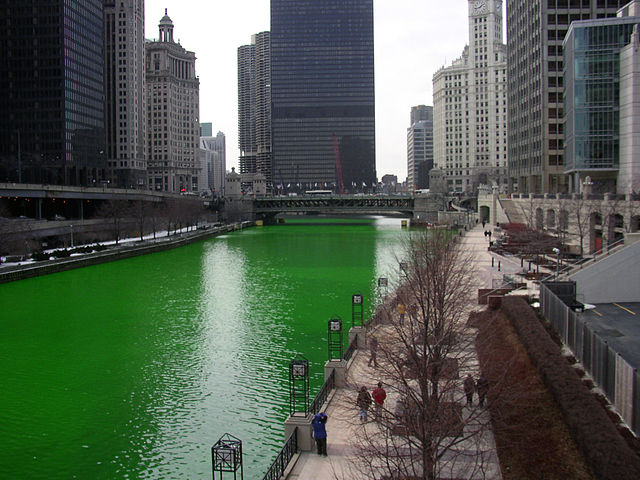Holiday traditions leave lasting impact
March 7, 2023
More than 14,000 firework displays illuminate America’s sky each Independence Day; approximately 4.6 million pounds of paper is thrown out every Christmas morning; a minimum of 46 million turkeys fill stomachs throughout the nation annually on Thanksgiving day; and, over 400,000 people line the Chicago River each St. Patrick’s day to watch a bunch of green junk be dumped into the river. We are slowly killing the planet with our oblivion!
Holidays bring people together in unique ways (ex: when all my extended family marks their calendar one day a year to pose for my grandma’s camera and decorate sugar cookies or on Halloween four years ago when my friends slept over… we couldn’t leave each other’s side after watching a few too many horror movies) and there is no doubt that all our special traditions are what make certain days of the year so memorable. But how can we sleep knowing that we brush all the environmental concerns under the rug when it comes to our own enjoyment?
Obviously, I am not going to stop wrapping gifts for my family in the holiday season. And I love setting fireworks off on July Fourth. Even with my love of these traditions, it is very apparent how little respect we show towards nature, especially when, for St. Patrick’s Day, we dump 40 pounds of dye into a massive river which is home to more than 70 species of fish and plants.
Junior Vivian Schmidt loves going to the St. Patrick’s Day parade with her family each year. With the holiday being her favorite, the tradition of dying the river green has always been special to her.
“I never thought twice about the river being green… it’s always just been a fun memory,” Schmidt said.
It all started in 1962 when Stephen Bailey, a member of the Chicago Journeymen Plumbers, noticed the dye they used to detect leaks left his overalls bright green. The co-chair of the St. Patrick’s day parade tested 100 pounds of the oil-based fluorescein (the dye for detecting leaks) in the Chicago River, which left it green for the entire week. After a couple years of experience, they found the perfect ratio for the coloring to last just one day. Then in 1966, environmentalists convinced the city to switch the concoction to a vegetable based powder.
Surprisingly, the dye is actually an orange powder, but when mixed with water it appears a fluorescent green. The cool thing about this tradition, for many of us, is that it originated in Chicago.
Recently, in attempts to fray passionate environmentalists, the city switched from 100 pounds of dye to 40. Moreover, the powder is eco-friendly and the river only stays green for about 24 hours. So, you may be wondering what the issue is.
AP Environmental Science teacher Kurt Trenkle says that he was OK with the idea of dying the river green partially because he is Irish himself. For years, the Chicago River was so polluted that adding some dye was the least of its concerns, according to Trenkle. The Chicago River has a problematic past, towards the end of the 1900s it was full of sewage and factory waste (which led to the forced separation of the river and lake).
“The idea of coloring the river green, definitely rubs people the wrong way,” Trenkle said. “… Especially for the younger generation, seeing a pristine river and then suddenly we dump green dye in it one day a year, feels very different.”
Regardless of the dye being “unharmful,” it encourages the catastrophic perception that our earth is not alive and flourishing. Are we aware of all the traditions and practices that DO negatively impact the environment? That is the problem. Personally, I would have assumed that the dye had some sort of effect on all the fish and plants in the river. All the trash that fills the Chicago River along with all of the dye does not seem like the best combination for an ecosystem to thrive.
Groups such as the Environmental Protection Agency and the Friends of the Chicago River mention that their main concern is for “copycats” to use unapproved dye in either other bodies of water or other portions of the river. According to NPR, to combat this, environmentalists spread word that conservation police will be patrolling the river on St. Patrick’s Day to discourage any unapproved harm.
Dying the river green not only created the notion that the Chicago River can be treated anyway anyone wants, but it also inspired San Antonio, Tampa, Indianapolis and other cities to dye their rivers and canals as well (thankfully all the main cities are at least on board with the eco-friendly solutions).
In addition to the coloring of the rivers, many cities have big parties and parades. Regardless of whether or not the dye itself harms wildlife, the waste post-parade correlates directly to the loss of countless animals.
Researchers from the state of North Carolina estimate that over one million animals die each year after eating trash or being entrapped in litter. It’s crazy to think how much harm can be done in one day when everyone comes together and disregards the environment. Thinking about the animals that directly suffer from our waste, helps me see this topic from a deeper viewpoint. It can be hard to comprehend how each person contributes to the disturbing effects of our aimlessness and unintentional actions.
There is no clear solution, however, when it comes to saving our environment and preserving nature. But if we all can treat the world with a little more respect we can decrease the negative consequences of all the things we enjoy. The nice thing about improving how we treat our earth is that it costs nothing. The best thing we can do is leave nature alone, which seems like it shouldn’t be as hard as it is. It all sounds so repetitive but if we can actually start recycling, re-using decorations, and volunteering to clean up after holidays and celebrations, there can be a difference!
This St. Patrick’s day is a great reminder of how much damage can be done in just 24 hours. It’s easy to live blind to all the downsides of the things we love. So on March 17, feel free to leave the mess of the leprechaun in your house and try to pick up any waste that makes it outside. Also definitely pinch anyone not wearing green, but try to leave our earth untouched.























































































